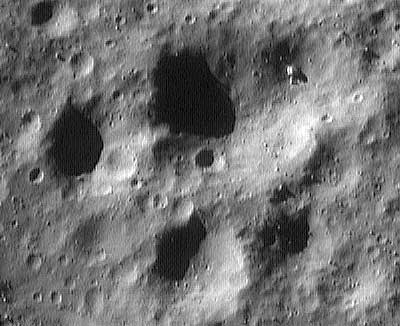|
Asteroid Used as a Weapon |
|
The photo above was taken by ESA of the Asteroid EROS... In the upper right corner you can see a strange object. This is one of the beat anomalies we have on file. NEAR image of the day for 2000 May 3 This image of Eros, taken from the NEAR Shoemaker spacecraft on May 1, 2000, is among the first to be returned from "low orbit." Between May and August, the spacecraft will orbit at altitudes near 50 kilometers (31 miles) or less. This will be the prime period of activity for some of the spacecraft's science instruments. The X-ray / gamma-ray spectrometer will build up maps of chemical abundances, while the laser rangefinder measures the shape of Eros to within meters (a few feet). At the same time the magnetometer will watch for indications of Eros' magnetic field and the near-infrared spectrometer will map rock types. The imager will take pictures of the entire surface of Eros that capture features as small as 4 meters (13 feet) across. This particular image, taken from an orbital altitude of 53 kilometers (33 miles), shows a scene about 1.8 kilometers (1.1 miles) across. Numerous craters and boulders as small as 8 meters (26 feet) across dot the landscape. The large, rectangular boulder at the upper right is 45 meters (148 feet) across. (Image 0132577092) |
|
| Posted by Jenab6 at Physics
Forum
Post ID 151609
Here's an assessment of the feasibility of diverting asteroid 1981 Midas into a collision with Earth in the year 2018. I'm posting this to show the potential military-political advantage to controlling access to space. Note the relatively small size of the divert delta-vee. Only about 301.5 meters per second will cause the asteroid to shift into a collision course. Elements used for Earth.
Elements used for 1981 Midas.
Midas divert delta-vee.
Transfer orbit is an ellipse with aphelion at departure. Elements of the Midas transfer
orbit.
Minimum distance between Earth's
orbit and the Midas
transfer orbit: 97.8 km
Transit time = 384.379 days.
Midas approaches Earth from
approximately
Midas' diameter: 3.4 kilometers
Jerry Abbott |
|
| NATURAL
METEOROIDS AS WEAPONS
RAND
Corporation
Availability Two well known
groups of asteroids—the
Atens and the Apollos currently cross earth’s
orbit, and each originates
in the main asteroid belt between Jupiter and
Mars. Astronomers have discovered
190 that are over 1 km in diameter and estimate
that there are 900. In
addition, the 1,500 Amor asteroids are believed to
be very large nearearth
objects that could pose significant future danger,
having the
Among the
smaller, potentially
useful objects may be over 1 million asteroids
over 30 m in diameter that
cross the earth’s orbit (Rabinowitz et al., 1994;
Shoemaker et al., 1995).
The objects among them that are important for this
discussion have diameters
ranging from a few tens of meters to a few hundred
meters, depending on
Diverting the course of an asteroid requires only a small DeltaV, if the deflection is done far enough in advance of earth impact. The displacement is proportional to both the lead time and DeltaV.1 Done well in advance, diverting an asteroid that would otherwise come no closer than midway between earth and moon requires imparting a DeltaV of at least several tens of meters per second to the asteroid. Deflecting an asteroid within days of its closest approach to earth would require a very large DeltaV, on the scale of kilometers per second. It is only possible to deflect an intermediate-size asteroid well in advance. |
|
| FAIR USE NOTICE: This page contains copyrighted material the use of which has not been specifically authorized by the copyright owner. Pegasus Research Consortium distributes this material without profit to those who have expressed a prior interest in receiving the included information for research and educational purposes. We believe this constitutes a fair use of any such copyrighted material as provided for in 17 U.S.C § 107. If you wish to use copyrighted material from this site for purposes of your own that go beyond fair use, you must obtain permission from the copyright owner. | |
|
|

Webpages © 2001-2016 Blue Knight Productions |
